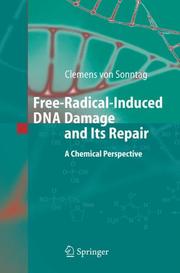| Listing 1 - 3 of 3 |
Sort by
|

ISBN: 9783540261209 3540261206 3642065546 9786610607907 1280607904 3540305920 Year: 2006 Publisher: Berlin ; New York : Springer,
Abstract | Keywords | Export | Availability | Bookmark
 Loading...
Loading...Choose an application
- Reference Manager
- EndNote
- RefWorks (Direct export to RefWorks)
Understanding of the molecular basis of DNA damage and its repair has increased dramatically in recent years, and substantial knowledge now exists concerning the products arising from free-radical attack on DNA. Free-radical DNA damage may lead to mutations, cancer, and cell death. Free radicals have various sources, notably ionizing radiation and oxidative stress. In radiotherapy for cancer and with some anticancer drugs, use is made of cell death by excessive DNA damage. The mechanisms leading to products of free-radical attack which have been studied in models and with small double-stranded DNA fragments are discussed in detail, and the basics of the underlying free-radical chemistry are dealt with in separate chapters.
DNA damage --- DNA repair --- Free radicals (Chemistry) --- ADN --- Radicaux libres (Chimie) --- Lésions --- Réparation --- DNA damage. --- Biochemical Processes --- Organic Chemicals --- Genetic Processes --- Inorganic Chemicals --- Chemical Processes --- Chemicals and Drugs --- Biochemical Phenomena --- Genetic Phenomena --- Chemical Phenomena --- Phenomena and Processes --- DNA Repair --- Free Radicals --- DNA Damage --- Biology --- Health & Biological Sciences --- Genetics --- Cytology --- DNA repair. --- Free radicals (Chemistry). --- Lésions --- Réparation --- EPUB-LIV-FT LIVBIOLO SPRINGER-B --- Deoxyribonucleic acid repair --- Repair, DNA --- Repair mechanisms in DNA --- Damage, DNA --- Life sciences. --- Molecular biology. --- Organic chemistry. --- Oncology. --- Biochemistry. --- Cell biology. --- Life Sciences. --- Biochemistry, general. --- Cell Biology. --- Life Sciences, general. --- Molecular Medicine. --- Organic Chemistry. --- Radicals (Chemistry) --- Free radical reactions --- Biochemical genetics --- Antimutagens --- Mutation (Biology) --- Cytology. --- Medicine. --- Oncology . --- Chemistry, Organic. --- Organic chemistry --- Chemistry --- Tumors --- Clinical sciences --- Medical profession --- Human biology --- Life sciences --- Medical sciences --- Pathology --- Physicians --- Biosciences --- Sciences, Life --- Science --- Cell biology --- Cellular biology --- Cells --- Cytologists --- Biological chemistry --- Chemical composition of organisms --- Organisms --- Physiological chemistry --- Composition --- Health Workforce --- Molecular biochemistry --- Molecular biophysics --- Biochemistry --- Biophysics --- Biomolecules --- Systems biology
Book
ISBN: 085066375X Year: 1987 Publisher: London : Taylor & Francis,
Abstract | Keywords | Export | Availability | Bookmark
 Loading...
Loading...Choose an application
- Reference Manager
- EndNote
- RefWorks (Direct export to RefWorks)
Book
ISBN: 9781843393139 1843393131 9781780400839 1780400837 Year: 2012 Publisher: IWA Publishing
Abstract | Keywords | Export | Availability | Bookmark
 Loading...
Loading...Choose an application
- Reference Manager
- EndNote
- RefWorks (Direct export to RefWorks)
Even though ozone has been applied for a long time for disinfection and oxidation in water treatment, there is lack of critical information related to transformation of organic compounds. This has become more important in recent years, because there is considerable concern about the formation of potentially harmful degradation products as well as oxidation products from the reaction with the matrix components. In recent years, a wealth of information on the products that are formed has accumulated, and substantial progress in understanding mechanistic details of ozone reactions in aqueous solution has been made. Based on the latter, this may allow us to predict the products of as yet not studied systems and assist in evaluating toxic potentials in case certain classes are known to show such effects. Keeping this in mind, Chemistry of Ozone in Water and Wastewater Treatment: From Basic Principles to Applications discusses mechanistic details of ozone reactions as much as they are known to date and applies them to the large body of studies on micropollutant degradation (such as pharmaceuticals and endocrine disruptors) that is already available. Extensively quoting the literature and updating the available compilation of ozone rate constants gives the reader a text at hand on which his research can be based. Moreover, those that are responsible for planning or operation of ozonation steps in drinking water and wastewater treatment plants will find salient information in a compact form that otherwise is quite disperse. A critical compilation of rate constants for the various classes of compounds is given in each chapter, including all the recent publications. This is a very useful source of information for researchers and practitioners who need kinetic information on emerging contaminants. Furthermore, each chapter contains a large selection of examples of reaction mechanisms for the transformation of micropollutants such as pharmaceuticals, pesticides, fuel additives, solvents, taste and odor compounds, cyanotoxins.
afvalwaterbehandeling --- ozonbehandeling --- ozon --- drinkwaterproduktie --- chemische reactie --- olefine --- aromatische verbinding --- stikstofverbinding --- waterzuivering --- zwavelretentie --- vrij radikaal --- Water --- Sewage --- Ozone --- Purification --- Ozonization. --- Reactivity. --- Ozone -- Reactivity. --- Pollutants -- Reactivity. --- Sewage -- Purification -- Ozonization. --- Water -- Purification -- Ozonization. --- Civil & Environmental Engineering --- Engineering & Applied Sciences --- Environmental Engineering --- Pollutants --- Oxonization. --- Ozonization --- Hydrology --- Chemical pollutants --- Contaminants, Environmental --- Environmental contaminants --- Environmental pollutants --- Chemicals --- Pollution --- Chemical tests and reagents --- Oxygen --- Technology & Engineering --- Environmental --- General --- Science --- Applied Sciences --- Environmental Science (see Also Chemistry --- Environmental)
| Listing 1 - 3 of 3 |
Sort by
|

 Search
Search Feedback
Feedback About UniCat
About UniCat  Help
Help News
News